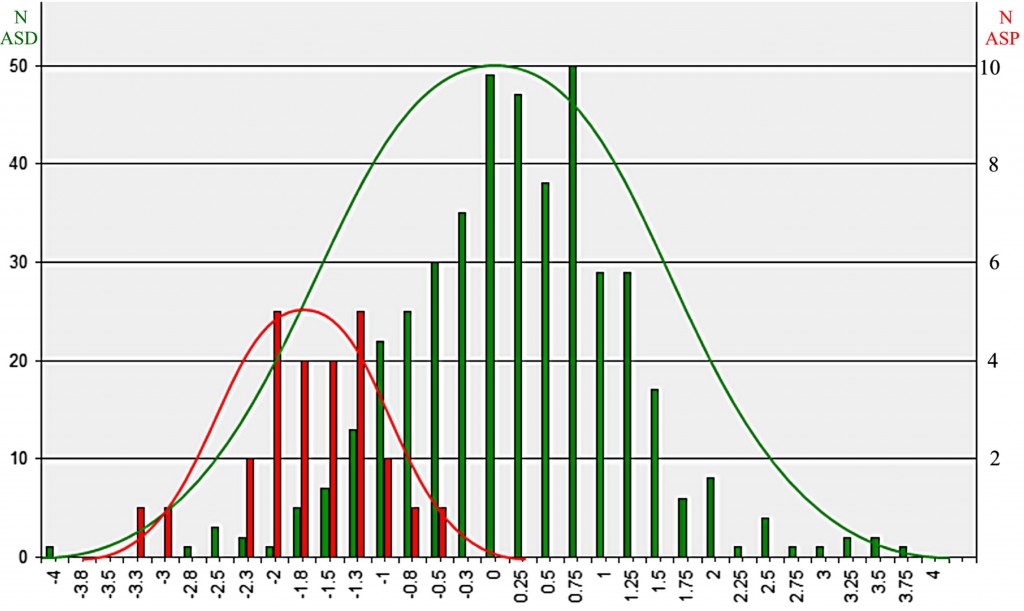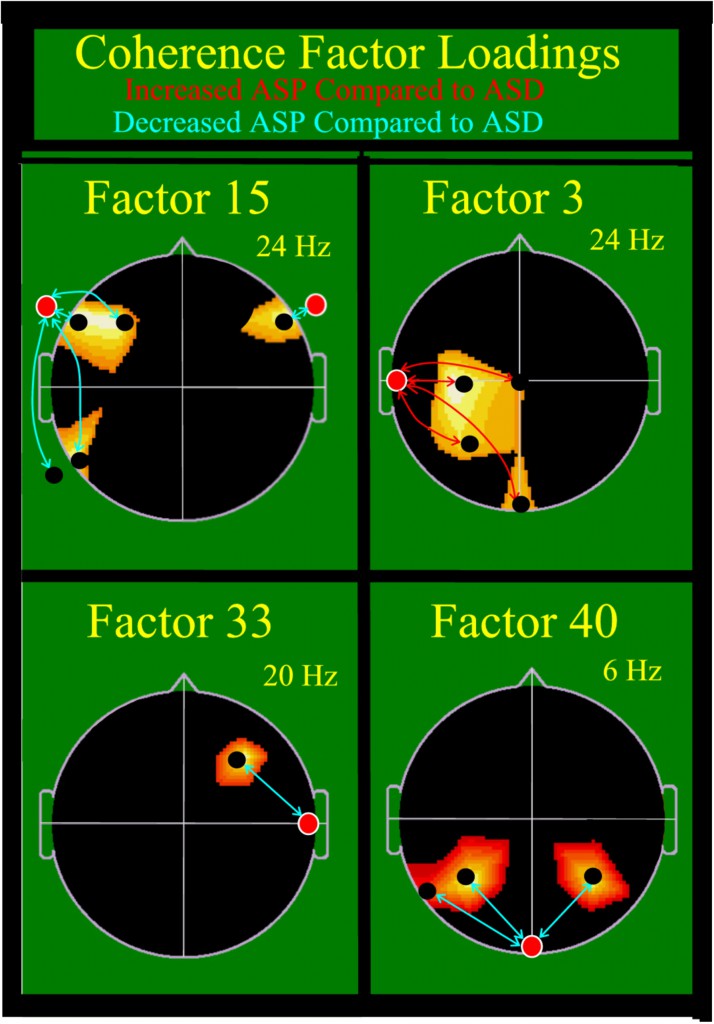
Asperger’s syndrome vs. autism spectrum disorders:
This histogram separates children with Asperger’s (in red) from those with autism spectrum disorders (green) based on EEG coherence variables. Although there is overlap with high-functioning autism, the Asperger’s children clearly form a distinct group. (Courtesy BMC Medicine)
Under the new DSM-V, published in May, Asperger’s is included under the general “autism spectrum disorders (ASD)” umbrella. This has raised concerns among families who feel their children with Asperger’s have unique needs that won’t be met in classroom programs designed for autism.
Frank Duffy, MD, a neurologist at Boston Children’s Hospital, believes it’s possible to objectively differentiate Asperger’s from ASDs using a new wrinkle on an old technology. Originally trained as an engineer, Duffy is expert at interpreting electroencephalography (EEG) signals—the wiggly lines that represent electrical activity in the brain.
He’s devised computational techniques that measure the degree of synchrony among signals gathered from 24 different electrodes on different parts of the scalp.
These “coherence” patterns, though not evident to the eye, reflect how the brain is wired, and how it processes and integrates information. And they clearly reveal different patterns of brain connections in children with Asperger’s as compared to children with autism.
“It’s very easy to separate Asperger’s from autism patients by EEG measures,” Duffy asserts. “We could eventually come to the point where diagnostic differences are defined directly by differences in brain activity.”
First, we need to rewind to last year, when Duffy presented results from studying 430 children, ages 2 to 12, with “classic” autism and comparing them with 554 neurotypical controls. The autism diagnoses relied upon the DSM-IV, the Autism Diagnostic Interview, Revised and/or the Autism Diagnostic Observation Schedule. Children with Asperger’s syndrome or very low or high-functioning autism were excluded. In the end, Duffy computed EEG coherence readings for more than 4,000 possible combinations of electrodes.
In the autism group, coherence tended to be reduced in brain areas at short distances from each other, while long-distance coherence was sometimes reduced, sometimes increased. Ultimately, Duffy found several dozen coherence factors that consistently distinguished the children with autism from the controls with more than 90 percent sensitivity.
The Asperger’s difference
In the new study, published July 31 in the open-access journal BMC Medicine, Duffy compared these two groups with an additional 26 children meeting behavioral criteria for Asperger’s.
Using 40 coherence factors, Duffy’s algorithm classified 25 of the 26—96 percent—as belonging to the autism sample. So clearly, the children with Asperger’s were closer to the autism profile than to the neurotypical controls. However, further coherence analysis correctly classified 24 of the 26 children—92 percent—as having clinical Asperger’s syndrome as distinct from ASDs. These classifications held up on repeated analyses.
What was different in the Asperger’s group? Duffy zeroed in on four EEG coherence factors (Factors 3, 15, 33 and 40) that best distinguished them from the group with ASDs. This graphic illustrates the differences in brain connectivity; imagine you’re looking down at the brain from above (see the nose at the top of each “head”):
The red and black dots indicate electrodes. Red lines between the dots indicate increased coherence between pairs of signals in the Asperger’s group, and blue-green lines indicate decreased coherence in the Asperger’s group.
So what does this mean?
Duffy hypothesizes that Factor 15, indicating reduced connectivity in the arcuate fasciculus, a brain structure involved in language, indicates a language deficiency, but that the Asperger’s brain compensates for this with increased connectivity in the left temporal region (Factor 3), allowing children to acquire language skills.
“Children with Asperger’s have very unique aspects to their language,” says Duffy. “The difference in coherence may account for their more stylized, literal use of language.”
As for Factors 33 and 40, which each show reduced coherence values in the Asperger’s group, Duffy proposes that they correspond to differences in visual-spatial functioning and in right-hemisphere areas thought to be involved in perceiving social and language nuance.
All this, of course, invites further investigation. Duffy is planning another study using coherence factors to distinguish children with autism from those with global developmental delay, which can often look like autism. With a larger sample size, he hopes to investigate whether there are differences between Asperger’s syndrome and high-functioning autism.
But in the meantime, since EEGs are relatively cheap diagnostic tools, Duffy feels they could eventually be developed to provide a diagnostic tool for autism in settings where there aren’t enough skilled behavioral clinicians, such as developing countries and certain underserved parts of the U.S.
“With some public and private support, I believe this could potentially be translated into a practical tool within my lifetime,” he says.
Citation:
![]() Duffy FH, Shankardass A, McAnulty GB, & Als H (2013). The relationship of Asperger’s syndrome to autism: a preliminary EEG coherence study. BMC medicine, 11 PMID: 23902729
Duffy FH, Shankardass A, McAnulty GB, & Als H (2013). The relationship of Asperger’s syndrome to autism: a preliminary EEG coherence study. BMC medicine, 11 PMID: 23902729








